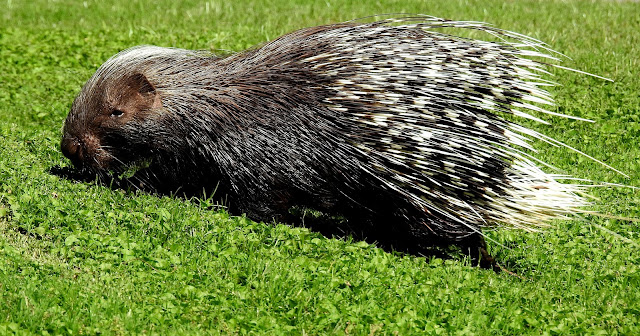The Cape porcupine (Hystrix africaeaustralis), Cape crested porcupine or South African porcupine, is a species of Old World porcupine native to central and southern Africa.
Cape porcupines are the largest rodents in Africa and also the world's largest porcupines. Cape porcupines are amongst the largest living rodents in the world; a few other rodents appear to be larger in body mass such as the capybara and the Eurasian and North American beavers. They are similar in appearance to, the slightly smaller and close relatives, the crested porcupines. They can most easily be distinguished from them by the presence of a band of short white spines along the midline of the rump. Indian porcupines are almost the same size on average as well, being slightly heavier on average than crested porcupine but slightly lighter than Cape porcupines.
Cape porcupines measure 63 to 81 centimetres (25 to 32 inches) long from the head to the base of the tail, with the tail adding a further 11–20 centimetres (4.3–7.9 inches). They weigh from 10 to 24 kilograms (22 to 53 pounds), with exceptionally large specimens weighing up to 30 kg (66 lb); males and females are not significantly different in size. The average weight of males from Zimbabwe was 16.9 kg (37 lb) and while the average for females there was 18.4 kg (41 lb) while in the Orange river valley of South Africa males averaged 12.3 kg (27 lb) and females averaged 13 kg (29 lb).
They are heavily-built animals, with stocky bodies, short limbs, and an inconspicuous tail. The body is covered in long spines up to 50 centimetres (20 in) in length, interspersed with thicker, sharply pointed, defence quills up to 30 centimetres (12 in) long, and with bristly, blackish or brownish fur. The spines on the tail are hollow, and used to make a rattling sound to scare away predators. An erectile crest of long, bristly hairs runs from the top of the head down to the shoulders. The spines and quills cover the back and flanks of the animal, starting about a third of the way down the body, and continuing onto the tail. The quills have multiple bands of black and white along their length, and grow from regularly spaced grooves along the animal's body; each groove holding five to eight quills. The remainder of the animal, including the undersides, is covered with dark hair.
The eyes and ears are relatively small, and the mobile whiskers are short. The feet have five clawed toes, although the first toes on the forefeet are vestigial. Females have two pairs of teats.









%2021.jpg)


